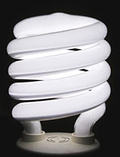 澳洲政府頒佈命令全國將逐步淘汰耗能、過時的白熾燈泡,在2010年前由螢光省電燈泡全面取代,並稱此為世界第一的創舉。這項新政策是由環境部長湯伯(Malcolm Turnbull)於21日公布,預計兩年後的溫室氣體排放量可減少約400萬噸。家居照明的花費也可因此最多減少66%。
澳洲政府頒佈命令全國將逐步淘汰耗能、過時的白熾燈泡,在2010年前由螢光省電燈泡全面取代,並稱此為世界第一的創舉。這項新政策是由環境部長湯伯(Malcolm Turnbull)於21日公布,預計兩年後的溫室氣體排放量可減少約400萬噸。家居照明的花費也可因此最多減少66%。
湯伯表示:「目前可以減少溫室氣體排放量最立即有效的方法,便是有效率地使用能源。」當耗能設施逐漸淘汰,溫室氣體排放量自然減少,預估自2008至2012年的年平均減少量達80萬噸。但澳洲環保人士指出,如果澳洲工業可以減少對火力發電及煤出口的依賴,溫室氣體排放量的減少將遠遠多過現在所估。
湯伯表示:「電力照明是我們生活中重要的一部份,全球電力照明所製造的氣體排放量,相當於70%家用汽車排放量,但效率仍舊不高。我們已經使用白熾燈泡125年,然而其中90%的能源都浪費掉了,主要是因為熱度。」
「普通的燈泡通常熱得拿都拿不住,熱能就這麼浪費掉,而且造成全球數百萬噸的二氧化碳排放。如果使用較有效率的照明,就不會有這樣的結果。」
湯伯表示:「更有效率的照明設備,例如螢光燈泡,只需使用20%的電力,就能產生同樣的照明效果。」
Trumpeting it as a "world first," the Australian government is mandating a nationwide phase out of inefficient, old-fashioned incandescent light bulbs in favor of compact fluorescent bulbs by 2010. The new policy, announced Tuesday by Environment Minister Malcolm Turnbull should reduce Australia’s greenhouse gas emissions by four million tonnes two years later. Household lighting costs could be reduced by up to 66 percent, the minister said.
"The most effective and immediate way we can reduce greenhouse gas emissions is by using energy more efficiently," Turnbull said. The reduction in emissions will increase as the phaseout progresses and the annual average reduction between 2008-2012 is estimated at around 800,000 tonnes. But Australian Greens and environmentalists said much more progress in cutting greenhouse gas emissions could be made if Australian industry reduced its reliance on coal-fired power and coal exports.
"Electric lighting is a vital part of our lives; globally it generates emissions equal to 70 percent of those from all the world’s passenger vehicles, but it is still very inefficient. We have been using incandescent light bulbs for 125 years and up to 90 percent of the energy each light bulb uses is wasted, mainly as heat."
"A normal light bulb is too hot to hold – that heat is wasted and globally represents millions of tonnes of CO2 [the greenhouse gas carbon dioxide] that needn’t have been emitted into the atmosphere if we had used more efficient forms of lighting."
"These more efficient lights, such as the compact fluorescent light bulb, use around 20 percent of the electricity to produce the same amount of light."





